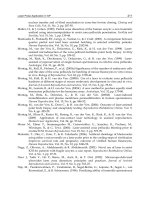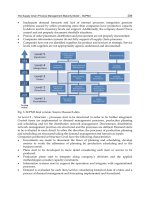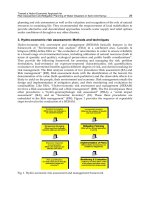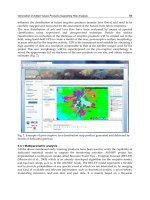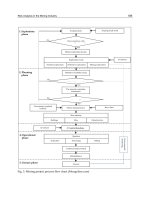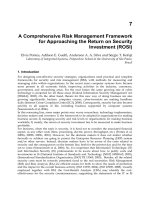Management and Services Part 12 pptx
Bạn đang xem bản rút gọn của tài liệu. Xem và tải ngay bản đầy đủ của tài liệu tại đây (326.47 KB, 7 trang )
Management and Services 70
Fig. 12. The framework of Geo-information sharing Grid based on Mobile Agent
3) If it is a native task, a native agent subsystem’s agent is started directly and dispatched to
native spatial information server. When arrived, the native agent subsystem’s agent sends a
service request to spatial data service which is built up in Globus Toolkits 4 and returns the
result to web server.
4) If it isn’t a native task, a Collaboration Query Agent is created and dispatched to Agency
Agent server, and then asks for querying spatial information servers. When obtains target
spatial information server’s address and port, web server starts proper agent subsystem’s
agent and dispatches it to target spatial information server. The agent communicates with
spatial data service which is built up in Globus Toolkits 4 and returns the result to web server.
5) While getting all the information needed, the web server returns it to user via web
explorer.
5. Conclusions
This Geo-information sharing platform provides integrated spatial information and
applications for users with the technology of Spatial Information Grid, the Grid platform of
OGSI.NET, and mobile agent. In this platform, a feasible method for spatial data sharing
and interoperability in grid environment is provided. It makes data accessing easier and
shields spatial data’s heterogeneity. Users can access spatial information resource through
uniform interface.
The interoperation of heterogeneous GIS is implemented in the Resource and Environment
Geo-information Sharing Architecture for the Southwestern China. Via uniform user
interface, web users can take advantage of geo-data and function provided by various Web
GISs. However, there are some problems that ought to be further solved, such as the
security of the access to spatial databases, the management of the Geo-information service
lifecycle, and etc.
6. Acknowledgments
This research was funded partly by the National Basic Research Program of China (also
called the 973 program, contract 2007CB714400), by National Key Technology Support
Program (contract 2006BAJ09B09), and by Open Research Fund Program (contract
GCWD200706) of Key Laboratory of Digital Mapping and Land Information Application
Engineering,State Bureau of Surveying and Mapping ” . The authors would also like to
thank everyone who has supported this effort through his thoughtful discussions of issues
raised in this paper.
7. References
A. L. Corte, A. Puliafito, and O. Tomarchio. (1999). An agent-based framework for mobile
users. in ERSADS’99, Madeira, Portugal,1999.
A. Puliafito, S. Riccobene, and M. Scarpa. (2001). Which paradigm should I use? An analytical
comparison of the client-server, remote evaluation and mobile agent paradigms.
Lecture Notes in Computer Science, vol.2150, 2001.
Boucelma, O., Esid, M., and Lacroiz, Z. (2002). A WFS-based Mediation System for GIS
Interoperability. Tenth ACM International Symposium on Advances in GIS, 2002,
pp. 23-28.
D. Chess, C. Harrison, and A. Kershenbaum.(1994). Mobile Agents: Are They a Good Idea?,
Yorktown Herghts, New York, Tech. Rep. RC 19887, (December 21,
1994-Declassified March 16, 1995), 1994
Glenn Wasson, Norm Beekwilder, Mark Morgan, etal. (2004). OGSI.NET: OGSI-compliance
on the .NET Framework.
Ian Foster, Carl Kesselman. (1999). The Grid: Blueprint for a Future Computing
Infrastructure, Morgan Kaufmann Publishers, USA, 1999.
Ian Foster, Carl Kesselman, Jeffrey Nick, and Steve Tuecke. (2002). The Physiology of the
Grid: An Open Grid Services Architecture for Distributed Systems Integration,
January 2002.
I. Foster, H. Kishimoto, A. Savva. (2005). The Open Grid Services Architecture, Version 1.0.
Joshua Lieberman. (2003). OpenGIS Web Services Architecture. Version: 0.3(2003-01-18).
LIU Qiang, CHENG Boyan. (2006). Constructing Geo-information Sharing Architecture.
GEO-SPATIAL INFORMATION SCIENCE [QUARTERLY], 2006, Vol. 9, ISSUE 3,
pp. 206~209
Jian Ma, Qiang Liu, Boyan Cheng, Yuancheng Sun. (2006). A Mobile Agent Based Spatial
Data Grid, 26th Anniversary IGARSS 2006 IEEE, pp. 3271~3274
Panagiotis A. Vretanos. (2005). Web Feature Service Implementation Specification. Open
Geospatial Consortium, 2005, Inc. OGC 04-094.
Praveen Ummadi. A white paper on Standards & Interoperability in GIS.
& Interoperability in GIS.pdf
Constructing geo-information sharing GRID architecture 71
Fig. 12. The framework of Geo-information sharing Grid based on Mobile Agent
3) If it is a native task, a native agent subsystem’s agent is started directly and dispatched to
native spatial information server. When arrived, the native agent subsystem’s agent sends a
service request to spatial data service which is built up in Globus Toolkits 4 and returns the
result to web server.
4) If it isn’t a native task, a Collaboration Query Agent is created and dispatched to Agency
Agent server, and then asks for querying spatial information servers. When obtains target
spatial information server’s address and port, web server starts proper agent subsystem’s
agent and dispatches it to target spatial information server. The agent communicates with
spatial data service which is built up in Globus Toolkits 4 and returns the result to web server.
5) While getting all the information needed, the web server returns it to user via web
explorer.
5. Conclusions
This Geo-information sharing platform provides integrated spatial information and
applications for users with the technology of Spatial Information Grid, the Grid platform of
OGSI.NET, and mobile agent. In this platform, a feasible method for spatial data sharing
and interoperability in grid environment is provided. It makes data accessing easier and
shields spatial data’s heterogeneity. Users can access spatial information resource through
uniform interface.
The interoperation of heterogeneous GIS is implemented in the Resource and Environment
Geo-information Sharing Architecture for the Southwestern China. Via uniform user
interface, web users can take advantage of geo-data and function provided by various Web
GISs. However, there are some problems that ought to be further solved, such as the
security of the access to spatial databases, the management of the Geo-information service
lifecycle, and etc.
6. Acknowledgments
This research was funded partly by the National Basic Research Program of China (also
called the 973 program, contract 2007CB714400), by National Key Technology Support
Program (contract 2006BAJ09B09), and by Open Research Fund Program (contract
GCWD200706) of Key Laboratory of Digital Mapping and Land Information Application
Engineering,State Bureau of Surveying and Mapping ” . The authors would also like to
thank everyone who has supported this effort through his thoughtful discussions of issues
raised in this paper.
7. References
A. L. Corte, A. Puliafito, and O. Tomarchio. (1999). An agent-based framework for mobile
users. in ERSADS’99, Madeira, Portugal,1999.
A. Puliafito, S. Riccobene, and M. Scarpa. (2001). Which paradigm should I use? An analytical
comparison of the client-server, remote evaluation and mobile agent paradigms.
Lecture Notes in Computer Science, vol.2150, 2001.
Boucelma, O., Esid, M., and Lacroiz, Z. (2002). A WFS-based Mediation System for GIS
Interoperability. Tenth ACM International Symposium on Advances in GIS, 2002,
pp. 23-28.
D. Chess, C. Harrison, and A. Kershenbaum.(1994). Mobile Agents: Are They a Good Idea?,
Yorktown Herghts, New York, Tech. Rep. RC 19887, (December 21,
1994-Declassified March 16, 1995), 1994
Glenn Wasson, Norm Beekwilder, Mark Morgan, etal. (2004). OGSI.NET: OGSI-compliance
on the .NET Framework.
Ian Foster, Carl Kesselman. (1999). The Grid: Blueprint for a Future Computing
Infrastructure, Morgan Kaufmann Publishers, USA, 1999.
Ian Foster, Carl Kesselman, Jeffrey Nick, and Steve Tuecke. (2002). The Physiology of the
Grid: An Open Grid Services Architecture for Distributed Systems Integration,
January 2002.
I. Foster, H. Kishimoto, A. Savva. (2005). The Open Grid Services Architecture, Version 1.0.
Joshua Lieberman. (2003). OpenGIS Web Services Architecture. Version: 0.3(2003-01-18).
LIU Qiang, CHENG Boyan. (2006). Constructing Geo-information Sharing Architecture.
GEO-SPATIAL INFORMATION SCIENCE [QUARTERLY], 2006, Vol. 9, ISSUE 3,
pp. 206~209
Jian Ma, Qiang Liu, Boyan Cheng, Yuancheng Sun. (2006). A Mobile Agent Based Spatial
Data Grid, 26th Anniversary IGARSS 2006 IEEE, pp. 3271~3274
Panagiotis A. Vretanos. (2005). Web Feature Service Implementation Specification. Open
Geospatial Consortium, 2005, Inc. OGC 04-094.
Praveen Ummadi. A white paper on Standards & Interoperability in GIS.
& Interoperability in GIS.pdf
Management and Services 72
Qiang Liu, Boyan Cheng. (2009). Constructing Geo-information Sharing GRID Architecture.
International Conference on management and Service Science 2009, Vol. 6: 022
Qiang Liu, Boyan Cheng, Xingfa Gu. (2005). Constructing Geo-information Sharing
Architecture for the Southwestern China Based on WMS, 25th Anniversary IGARSS
2005 IEEE, Vol 2, pp. 971~974.
S. Tuecke, I. Foster, S. Graham, et al. (2003). Open Grid Services Infrastructure (OGSI).
Xue, Y., Wang, J., Sheng, X., & Guo, H. (2003). Building Digital Earth with GRID
Computing–The Preliminary Results, Proceedings of Digital Earth 2003, 2003, pp.
804-812
Yuan Xiang-ru, Gong Jian-ya, Lin Hui, Chen Li-li. (1999). Internet GIS Approach to
Interoperability of Heterogeneous Geographic Information Processing
Environment. Journal of Wuhan Technical University of Surveying and Mapping,
Sept.1999, Vol.24 No.3, pp. 194-198
Realization of lowpass and bandpass leapfrog lters using OAs and CCCIIs 73
Realization of lowpass and bandpass leapfrog lters using OAs and
CCCIIs
Xi Yanhui and Peng Hui
X
Realization of lowpass and bandpass
leapfrog filters using OAs and CCCIIs
Xi Yanhui
1,2
and Peng Hui
1
1
School of Information Science & Engineering, Central South University,
Changsha 410083, China
2
Electrical and Information Engineering College, Changsha University
of Science & Technology, Changsha 410077
Abstract
The systematic procedure for realizing lowpass and bandpass leapfrog ladder filters using
only active elements is presented. The proposed architecture is composed of only two
fundamental active building blocks, i.e., an operational amplifier(OA) and a Current
Controlled Conveyor II (CCCII), without external passive element requirement, making the
approach conveniently for further integrated circuit implementation with systematic design
and dense layout. The characteristic of the current transfer function can be adjusted by
varying the external bias currents of CCCIIs. As illustrations to demonstrate the systematic
realization of current-mode ladder filters, a 3rd-order Butterworth low-pass filter and a 6th-
order Chebyshev bandpass filter are designed and simulated using PSPICE.
Keywords: operational amplifier (OA); current controlled conveyor II (CCCII); leapfrog
filters; ladder structure; active-only circuits
EEACC: 1270
CLC number: TN713 Document code: A
1. Introduction
Analog designs have been viewed as a voltage-dominated form of signal processing for a
long time. However in the last decade current-mode signal-processing circuits have been
demonstrated and well appreciated over their voltage-mode counterparts due to the main
featuring of wide bandwidth capability. Designs for active filter circuits using high
performance active devices, such as, operational amplifier(OA), operational
transconductance amplifier(OTA), second generation current conveyor(CCII) and so on,
have been discussed previously
[1-2]
. Due to the fact that active filter designs utilizing the
Project supported by the Natural Science Foundation of Hunan Province (NO. 06JJ50117)
Corresponding author Email:
5
Management and Services 74
finite and complex gain nature of an internally compensated type operational amplifier are
suitable for integrated circuit(IC) fabrication and high frequency operation. Several
implementations in continuous-time filters using only active components are recently
available in the literature
[3-6]
. They have been demonstrated that the realizations of the
resistor-less and capacitor-less active-only circuit would be attractive for simplicity,
integratability, programmability and wide frequency range of operation. However, a design
approach with only active architectures that are efficient for systematic design and very
large scale integration(VLSI) has not been reported sufficiently.
The paper deals with the alternative systematic approach that has been used the leapfrog
structure to obtain current-mode ladder active filters with the employment of all-active
elements. The proposed design approach is quite simple and systematic which has no
passive element requirements. The basic building blocks of all circuits mainly consist of OA
and CCCII. The obtained feature of the filter constructed in this way is a general structure
and is able to adjust the characteristic of the current transfer function by electronic means.
Owing to all-resulting circuits are implemented such a way that employs only active-
element sub-circuits and minimizes the number of different fundamental building blocks. It
is not only easy to construct from readily available IC type, but also significantly simplified
in the IC design and layout. As examples to illustrate that the approach considerably
simplifies for the current-mode ladder filter realizations, the leapfrog-based simulation of a
3rd-order Butterworth lowpass and a 6th-order Chebyshev bandpass filters are designed.
2. Basic active building blocks
2.1 Operational Amplifier(OA)
The first fundamental active device is to be an internally compensated type operational
amplifier(OA) as shown with its symbolic representation in Fig. 1. As is known in practice,
the open-loop amplifiers have a finite frequency-dependent gain. If
a
is the -3dB
bandwidth and by considering for the frequencies
a
, the open-loop voltage gain
)(sA of an OA will be henceforth characterized by
s
B
s
A
sA
a
aO
)(
(1)
where B denotes the gain-bandwidth product(GBP) in radian per second, which is the
product of the open-loop DC gain A
O
and the -3dB bandwidth
a
Fig. 1. Symbol of an OA
2.2 Current Controlled Conveyor II (CCCII)
A CCCII is a three-port active element. The port relations of a CCCII is shown in Fig. 2,
characterized by the relationship
z
x
y
i
v
i
010
01
000
x
R
z
x
y
v
i
v
(2)
Fig. 2. Electric symbol of CCCII
The positive and the negative sign are corresponding to the CCCII+ and CCCII-
respectively, and R
x
is input resistance at port X. For the circuit of Fig. 2 the parasitic
resistance , can be expressed as
B
T
x
I
V
R
2
(3)
Where V
T
is the thermal voltage 26
T
V mV at 27℃and I
B
is the bias current of the CCCII.
It is seen from equation (3) that the internal resistance R
x
is adjustable electronically through
the biasing current I
B
.
3. Realization of lowpass and bandpass leapfrog ladder filters
Since the doubly terminated LC ladder network has been receiving considerable attention
and popular due to it shares all the low sensitivity and low component spread of the RLC
prototypes
[7-12]
. An systematic approach to realize current-mode ladder filters using only
active elements is proposed. It is based on the leapfrog structure representation, which is
derived from the passive RLC ladder prototypes. To demonstrate the proposed design
approach, consider the general resistively terminated current-mode ladder filter with
parallel impedances and series admittances shown in Fig. 3. The relations of the currents-
voltages for the branches, the meshes and the nodes in this filter can be interrelated by
2
1
1
I
R
V
II
S
S
,
111
ZIV
222
YVI
,
312
VVV
423
III ,
333
ZIV ,
,
Realization of lowpass and bandpass leapfrog lters using OAs and CCCIIs 75
finite and complex gain nature of an internally compensated type operational amplifier are
suitable for integrated circuit(IC) fabrication and high frequency operation. Several
implementations in continuous-time filters using only active components are recently
available in the literature
[3-6]
. They have been demonstrated that the realizations of the
resistor-less and capacitor-less active-only circuit would be attractive for simplicity,
integratability, programmability and wide frequency range of operation. However, a design
approach with only active architectures that are efficient for systematic design and very
large scale integration(VLSI) has not been reported sufficiently.
The paper deals with the alternative systematic approach that has been used the leapfrog
structure to obtain current-mode ladder active filters with the employment of all-active
elements. The proposed design approach is quite simple and systematic which has no
passive element requirements. The basic building blocks of all circuits mainly consist of OA
and CCCII. The obtained feature of the filter constructed in this way is a general structure
and is able to adjust the characteristic of the current transfer function by electronic means.
Owing to all-resulting circuits are implemented such a way that employs only active-
element sub-circuits and minimizes the number of different fundamental building blocks. It
is not only easy to construct from readily available IC type, but also significantly simplified
in the IC design and layout. As examples to illustrate that the approach considerably
simplifies for the current-mode ladder filter realizations, the leapfrog-based simulation of a
3rd-order Butterworth lowpass and a 6th-order Chebyshev bandpass filters are designed.
2. Basic active building blocks
2.1 Operational Amplifier(OA)
The first fundamental active device is to be an internally compensated type operational
amplifier(OA) as shown with its symbolic representation in Fig. 1. As is known in practice,
the open-loop amplifiers have a finite frequency-dependent gain. If
a
is the -3dB
bandwidth and by considering for the frequencies
a
, the open-loop voltage gain
)(sA of an OA will be henceforth characterized by
s
B
s
A
sA
a
aO
)(
(1)
where B denotes the gain-bandwidth product(GBP) in radian per second, which is the
product of the open-loop DC gain A
O
and the -3dB bandwidth
a
Fig. 1. Symbol of an OA
2.2 Current Controlled Conveyor II (CCCII)
A CCCII is a three-port active element. The port relations of a CCCII is shown in Fig. 2,
characterized by the relationship
z
x
y
i
v
i
010
01
000
x
R
z
x
y
v
i
v
(2)
Fig. 2. Electric symbol of CCCII
The positive and the negative sign are corresponding to the CCCII+ and CCCII-
respectively, and R
x
is input resistance at port X. For the circuit of Fig. 2 the parasitic
resistance , can be expressed as
B
T
x
I
V
R
2
(3)
Where V
T
is the thermal voltage 26
T
V mV at 27℃and I
B
is the bias current of the CCCII.
It is seen from equation (3) that the internal resistance R
x
is adjustable electronically through
the biasing current I
B
.
3. Realization of lowpass and bandpass leapfrog ladder filters
Since the doubly terminated LC ladder network has been receiving considerable attention
and popular due to it shares all the low sensitivity and low component spread of the RLC
prototypes
[7-12]
. An systematic approach to realize current-mode ladder filters using only
active elements is proposed. It is based on the leapfrog structure representation, which is
derived from the passive RLC ladder prototypes. To demonstrate the proposed design
approach, consider the general resistively terminated current-mode ladder filter with
parallel impedances and series admittances shown in Fig. 3. The relations of the currents-
voltages for the branches, the meshes and the nodes in this filter can be interrelated by
2
1
1
I
R
V
II
S
S
,
111
ZIV
222
YVI
,
312
VVV
423
III ,
333
ZIV ,
,
Management and Services 76
jjj
YVI ,
11
jjj
VVV
11
iii
III
,
iii
IZV
,
111
nnn
YVI ,
nnn
VVV
21
and
11
nnn
III ,
nnn
ZIV (4)
Where ),,5,3,1( ni and ),,6,4,2( nj . Equation (4) can be represented by leapfrog
block diagram depicted in Fig. 4, where the output signal of each block is fed back to the
summing point input of the preceding block. In contrast with the conventional simulation
topology, however, we will present a simple, systematic and more efficient method unique
to active-only current mode ladder filters by using the features of an OA and a CCCII.
Fig. 3. General resistively terminated current-mode ladder prototype
Fig. 4. Leapfrog block diagram of the general ladder prototype of Fig. 3
3.1 Lowpass leapfrog realization
As an example to illustrate the design procedure, consider the current-mode 3rd-order all-
pole LC ladder lowpass prototype with regarding the terminating resistors shown in Fig. 5.
The design techniques of these partial conversions can be accomplished in the way as
shown in Fig. 6, through the use of only an OA and a CCCII as mentioned. Therefore, the
circuit parameters have the typical values calculated by
ii
xi
CB
R
1
for ni ,,7,5,3,1
and
jjxj
LBR for 1,,8,6,4,2 nj (5)
Where B
k
(k=i or j)represents the GBP of the k-th OA.
Based on the directed simulation of the LC branch as shown in Fig. 6, the system diagram
thus straightforwardly derived from the passive RLC ladder circuit of Fig. 5 can be shown
in Fig. 7. The design equations of the circuit parameters can be expressed as follows
LSx
RRRR
11
1
1
CB
R
x
222
LBR
x
and
33
3
1
CB
R
x
(6)
Note that all elements, which simulate the behavior of capacitor and inductor, are tunable
electronically through adjusting the resistor parameters, R
x
.
Fig. 5. 3rd-order all-pole LC ladder lowpass prototype
iCi
IZV
ii
xi
CB
R
1
(a) parallel branch impedance
jLj
VYI
jjxj
LBR
(b) series branch admittance
Fig. 6. Partial branch simulations using OA and CCCII of the lowpass network of Fig. 5
